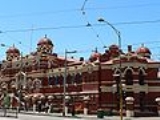
City Baths, Melbourne
Encyclopedia
City Baths, in Melbourne, Australia, is a historically significant building. Located at 420 Swanston Street
, it is of architectural significance.
The Melbourne City Council opened the first Melbourne City Baths on 9 January 1860, which housed public baths. The objective was to stop people from bathing in the Yarra River
, which by the 1850s had become quite polluted and the cause of an epidemic of typhoid fever which hit the city resulting in many deaths. However, people continued to swim and drink the water. The Baths were leased to a private operator, but lack of maintenance resulted in such deterioration of the building that the Baths were closed in 1899.
New baths designed by John James Clark
were opened on 23 March 1904. Strict separation of men and women was maintained, right down to separate street entrances. Two classes of facilities were maintained, with second class baths in the basement and first class baths on the main floor. Mixed bathing
was introduced in 1947 and the popularity of the swimming pool began to increase.
The Baths now house a swimming pool
, squash courts and a gymnasium
. The swimming pool is divided into four lanes, an Aqua Play lane, a Medium Lane, a Fast Lane and a Slow Lane (or Aquatic Education, when swimming lessons are given) to cater for all types of swimmers. There is also a spa
and a sauna
.
Swanston Street, Melbourne
Swanston Street is a major thoroughfare in the centre of Melbourne, Australia. It is historically one of the main streets of central Melbourne, laid out in 1837 as part of the Hoddle Grid, the layout of major streets that makes up the central business district...
, it is of architectural significance.
The Melbourne City Council opened the first Melbourne City Baths on 9 January 1860, which housed public baths. The objective was to stop people from bathing in the Yarra River
Yarra River
The Yarra River, originally Birrarung, is a river in east-central Victoria, Australia. The lower stretches of the river is where the city of Melbourne was established in 1835 and today Greater Melbourne dominates and influences the landscape of its lower reaches...
, which by the 1850s had become quite polluted and the cause of an epidemic of typhoid fever which hit the city resulting in many deaths. However, people continued to swim and drink the water. The Baths were leased to a private operator, but lack of maintenance resulted in such deterioration of the building that the Baths were closed in 1899.
New baths designed by John James Clark
John James Clark
John James Clark , an Australian architect, was born in Liverpool, England. Clark’s 30 years in public service, in combination with 33 in private practice, produced some of Australia’s most notable public buildings, as well as at least one prominent building in New Zealand.-Biography:John James...
were opened on 23 March 1904. Strict separation of men and women was maintained, right down to separate street entrances. Two classes of facilities were maintained, with second class baths in the basement and first class baths on the main floor. Mixed bathing
Mixed bathing
Mixed bathing is a term that refers to members of the opposite gender swimming together in the same pool. In ancient Rome, mixed bathing was never the rule in public installations, although it did occur in private facilities. Today, in Japan, the practice is not common...
was introduced in 1947 and the popularity of the swimming pool began to increase.
The Baths now house a swimming pool
Swimming pool
A swimming pool, swimming bath, wading pool, or simply a pool, is a container filled with water intended for swimming or water-based recreation. There are many standard sizes; the largest is the Olympic-size swimming pool...
, squash courts and a gymnasium
Gym
The word γυμνάσιον was used in Ancient Greece, that mean a locality for both physical and intellectual education of young men...
. The swimming pool is divided into four lanes, an Aqua Play lane, a Medium Lane, a Fast Lane and a Slow Lane (or Aquatic Education, when swimming lessons are given) to cater for all types of swimmers. There is also a spa
Spa
The term spa is associated with water treatment which is also known as balneotherapy. Spa towns or spa resorts typically offer various health treatments. The belief in the curative powers of mineral waters goes back to prehistoric times. Such practices have been popular worldwide, but are...
and a sauna
Sauna
A sauna is a small room or house designed as a place to experience dry or wet heat sessions, or an establishment with one or more of these and auxiliary facilities....
.

